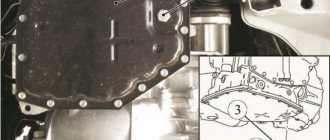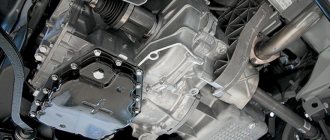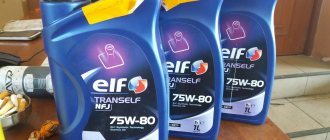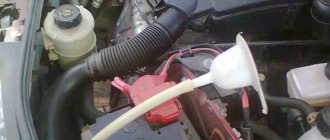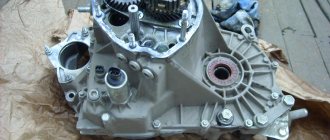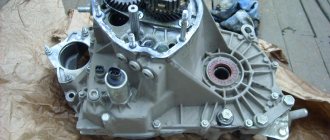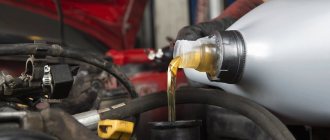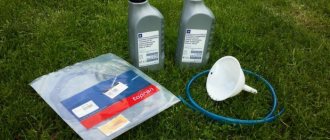The joint production of AvtoVAZ and Renault equipped Lada Largus cars with five-speed gearboxes. Depending on the configuration, gearboxes marked JR5 and JH3 are installed.
On more common versions with a 1.6-liter 8-valve engine and a 1.6-liter 16-valve engine, a JH3 manual transmission is installed.
The maintenance regulations do not provide for changing the oil in the Lada Largus gearbox. Although cars are adapted for harsh operating conditions, it is recommended to carry out lubricant diagnostics every 15,000 km.
This is done using a visual inspection. It is enough to unscrew the filler plug at the end of the box closer to the cooling radiator.
Causes and signs of oil losing its properties
If the transmission fluid is darkened or black in color, this may indicate that the lubricant has undergone a chemical change as a result of severe contamination with wear products of the gearbox elements (gear shafts and synchronizers) or a violation of the tightness of the gearbox (moisture and dirt entering through the seals of the drives or input shaft ).
- The smell of burnt oil in Lada Largus. May indicate insufficient lubrication levels due to leaks. Under heavy loads on the unit, cooling of the rubbing parts is not adequately ensured.
- If shifting gears is difficult, you may hear some noise or hum at certain speeds or when idling. The lubricating properties of the transmission fluid are partially lost or the level in the gearbox housing is insufficient.
- Increased wear of gearbox elements. Aggressive driving style and incorrect gear shifting.
- Mileage over 60,000 km since previous replacement. It is at this interval that service stations recommend replacing the transmission fluid.
Characteristics of gearboxes in different modifications of Lada Largus
The above models of gearboxes have various modifications designed for installation on certain machines. For example, the JR5 517 gearbox is installed on a van with K4M and K7M engines. The JR5 549 is combined with the K4M engine in both a five- and seven-seat van. The JR5 551 gearbox works with the eight-valve engine on the station wagon, and the JH3 540 modification is usually installed in the five-seater Largus with an eight-valve engine.
Both gearbox models are made of an aluminum alloy housing, in which are mounted:
- differential;
- final drive gear;
- clutch housing.
Inside the Lada Largus gearbox housing there is a primary shaft with a set of drive gears and a secondary shaft with driven gears located next to it. To ensure coordinated operation of the primary and secondary shafts, synchronization rings are installed on them. The difference between the variations of speed boxes lies in the gear ratios between the primary and secondary shafts. The difference between the JH3 and JR5 models is the design of the clutch and gear shift control.
The clutch on the JH3 unit is controlled via a cable connected to the clutch pedal, and gear shifting in the box occurs via a rod connected to the gearshift knob.
In the JR5 model, the transmission of force to the release bearing is carried out by a hydraulic system, which includes the main and working cylinders. The gearbox is controlled by two cables connected to the gear shift knob. At the same time, the cables are not interchangeable; each of them has its own functional purpose.
Before deciding on the purchase of a gearbox, it is necessary to evaluate the features of the automatic and manual transmission. A car with an automatic transmission has a number of advantages over a manual transmission, but it also has undeniable disadvantages.
Advantages and disadvantages of automatic transmission Lada Largus
| Advantages | Flaws |
| Excellent handling | Expensive repairs |
| Good acceleration dynamics | Frequent malfunctions |
| Multiple speed shift modes | High price |
| Ease of driving in urban environments | Inability to start the car when the battery charge is low (from a pusher) |
Therefore, before buying a Lada Largus with automatic transmission, you should weigh the pros and cons. In particular, it is necessary to understand in what conditions the car will be used most often.
Oil selection
The manufacturer uses transmission lubricant ELF TRANSELF TRJ 75W-80 (No. 194757) or 75W-90 (No. 195286).
Good analogues include Casrtol Syntrans Transaxle 75W-90 and Motul Gear300 75 W-90. All of the listed oils have the necessary API specification tolerances: GL - 4. They have high lubricating and detergent properties.
The use of lubricants for a Lada Largus car with a different approval is not recommended. A different additive package may affect the functional qualities of soft metal box elements (synchronizers).
Semi-synthetic lubricants, for the most part, have mineral substances, some synthetic substances and a certain percentage of additives responsible for enhancing the properties of oils.
Synthetic fluids are based only on synthetic substances. Produced from hydrocacking substances with the addition of additives.
Synthetic gear lubricants have better characteristics than semi-synthetic ones, but are more expensive.
The choice of oil viscosity depends on the climatic operating conditions of Largus. Thicker lubricants have proven themselves to be excellent in hot conditions. Technical fluids with lower viscosity require less time to warm up in sub-zero temperatures.
Technical characteristics of Lada Largus
In technical terms, the station wagon has a decent chassis with a McPherson front suspension with wishbones and an anti-roll bar. At the rear there is an H-shaped beam on trailing arms. There are ventilated disc brakes at the front and drum brakes at the rear with optional ABS.
Powertrains of the Lada Largus include two 1.6-liter petrol options from Renault:
- 1. Motor K7M 710 with 84 hp;
- 2. Engine K4M 697 with a power of 102 hp.
The station wagon equipment is complemented by:
- power steering;
- three-point seat belts;
- front electric windows;
- front and side airbags;
- Isofix child car seat fastening system.
Step-by-step instruction
Changing the oil in the box is carried out on a well-warm-up car.
Important! The temperature of the transmission fluid in the box of the Lada Largus should be 60 degrees. It is determined by a special device - a scanner. If this is not the case, the car warms up to the operating temperature of the internal combustion engine. The gearbox lubricant temperature will correspond to 60 degrees. This will facilitate good oil drainage. Fig 3
- For access and convenience, we drive the car onto an overpass or inspection hole.
- Apply the parking brake.
- We turn on the transmission.
- We go down into the inspection hole and remove the engine protection. Six 10mm bolts.
- Unscrew the plastic filler plug by hand. Using a special four-sided wrench, remove the drain plug.
- Drain the oil into the prepared container. If there were no leaks, we get approximately 2.5-2.8 liters of waste. The full volume of 3.1 liters cannot be drained due to the design features of the upper row of gears.
- We replace the sealing washer with a new copper or aluminum one.
- We wipe the drain neck with a rag and screw the clean plug back on. Tighten with a force of 30 Hm. We use a torque wrench. If there is no key, tighten the wrench tightly enough to avoid possible oil leaks. But not too much, so as not to spoil the edges and break the thread.
- Using a syringe, fill in new transmission fluid through the filler hole. If you don’t have a syringe, take a hose with an outer diameter of no more than 16 mm and a funnel. Open the hood of the car and, through the top, insert the hose into the filler neck.
- Fill with oil until grease flows out of the same hole. The filler hole is also a control hole. The lower level, which is the norm. Before tightening the filler plug, inspect the sealing rubber for integrity.
- If necessary, to eliminate smudges, replace the rubber band or plug assembly with a new one. We start the car for a few minutes. Then we inspect the gearbox for oil leaks.
- Reinstall the engine protection.
- To carry out work on replacing the gearbox lubricant of a Lada Largus car, you can turn to professionals or do the work yourself.
Is it worth changing the oil in manual transmissions at all - video
Checking the level and topping up
Before changing or adding lubricant, you should check the oil level in the box. This is not as difficult to do as many may think. If you have minimal experience and skills, you can easily cope with the task with your own hands. In the case of a Lada Largus car, for work you will need to take:
- a syringe that will be used to add the missing liquid;
- rags;
- an empty container for several liters;
- key square for 8;
- oil similar to what is in the box.
Special syringes are used, available in auto parts stores. Do not confuse them with medical syringes, which are not suitable for such purposes. Special topping and filling tools have a hose that allows easy access to the filler neck. When everything is ready, you can begin to assess the amount of oil in the box and add the missing amount of lubricating fluid to the Largus gearbox.
The work is carried out according to the following algorithm of actions:
Remove the engine protection. People often call it the central mudguard. The essence does not change from the name. Find the filler plug, which can often be easily unscrewed with a square wrench. Before opening the cap, place an empty prepared container under it to avoid spilled puddles of oil. According to the standards, the level should be located slightly below the filler hole. If it is less, then you will need to add the missing amount of gear lubricant. A syringe pre-filled with oil is inserted into the filler neck. Gradually pour in the viscous liquid. At some point, lubricant will begin to flow through the hole.
Wait until it stops running completely, then wipe everything with a rag and screw the plug back into place. During the process of checking and topping up, pay attention to the condition of the rubber O-ring on the plug. If the machine is used for a long time and actively, the ring may wear out
It is better to replace it immediately, since a worn seal will break the seal and the oil will gradually leak out. Such a ring costs about 5 - 10 rubles, so serious expenses for such repairs will not be required.
If you did everything correctly, the oil is not leaking anywhere and the gearbox is functioning normally, then the transmission fluid level is sufficient and you can continue to operate your car.
How to check the level and top up?
It is recommended to check the lubricant level in the Lada Largus transmission before replacing or topping up. The control procedure itself is quite simple and quickly feasible. Here you will need a minimum of skills and the following list of aids and tools:
- a syringe that allows you to add liquid;
- rags and a container that can hold about three liters;
- square key size 8;
- lubricant, similar in type and origin to that indicated in our material.
If a syringe is not available, it can be freely purchased in stores specializing in auto products. This device should not be confused with medical supplies, which, of course, are absolutely inapplicable in this situation. An addition can be a hose that provides easy access to the filler neck. After preparing the specified funds, you can safely move on to monitoring the level and topping up, if such a need arises as a result of the “monitoring mission”.
For control actions, the following algorithm will be optimal.
We remove the motor protection. Among car enthusiasts, this protective part is called the central mudguard. We find the drain plug of the box and unscrew it using the designated “square” key. Before unscrewing, place a container under the hole. We estimate the level, which, in accordance with regulatory standards, should be located slightly below the lower edge of the filler neck. When this level is less than the designated limit, we top up. To do this, insert the tip (hose) of the syringe into the filler neck and perform the usual action of squeezing the liquid into the unit. We “pump” the box with oil until the return flow of oil begins through this hole. Here we complete the refilling, and carefully wipe the perimeter around the hole with a prepared rag. All that remains is to tighten the plug, which we do without any hesitation. Don't forget to inspect the condition of the sealing ring on the plug. If it is worn out, we replace it
The price issue of this important product is scanty (about 10-15 rubles).
Now you can start operating the car, having first made sure that the gearbox oil is filled and there are no leaks.
